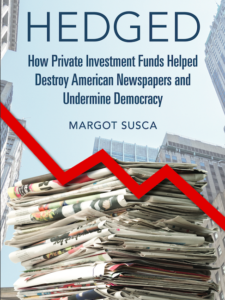
In “Hedged: How Private Investment Funds Helped Destroy American Newspapers and Undermine Democracy,” which is expected to be published by the University of Illinois Press in January, Margot Susca aims to tell the untold history of how the ultrawealthy have shaped local newspapers throughout the U.S. Through in-depth interviews and a trove of documents, Susca examines everything from ownership and power, to layoffs and cash-outs, to closings and debt. It’s the greed of corporate owners, “Hedged” argues, that has let newspapers’ responsibility to the public fall to the wayside.
In the following excerpt from Chapter 4, “Mergers and Acquisitions,” Susca speaks to journalists about how their newspapers have changed and deteriorated after they were acquired by private equity firms:
At Gannett, GateHouse, Lee Enterprises, and MediaNews Group, former journalists I interviewed remembered unsuccessfully pushing for a transition strategy. Kurt Greenbaum arrived at the St. Louis Post-Dispatch, owned by Lee Enterprises, in mid-2002, which he described as a time when many print reporters and editors still scorned digital in the years after the dot-com bubble burst. Greenbaum, age fifty-seven at the time of our interview, took a position in 2002 as online news editor in St. Louis. He remembered feeling at first like an outsider pushing for digital to be taken seriously. “To some people in the newspaper industry I was an insurgent,” Greenbaum told me. “And I represented a problem. I feel like I was a voice crying out in the wilderness saying, ‘We better be prepared for it. And we better invest in it and make our peace with it. It’s coming.’” We talked in September 2020 about that time period at newspapers before the worst of the recession, and Greenbaum remembered the newspaper earning 25 percent profit margins. He explained that newspaper management should have devoted resources to the digital transition, but those profit targets hindered long-range planning. He thought Lee executives should have devoted resources to aid the transition online, similar to having a dedicated staff to handle photojournalism. “I shouldn’t have been put in the position where I represented more work,” Greenbaum said. “We should have taken 15 percent profit margins instead of 25 percent profit margins, so we could do the work getting the resources we needed.” Greenbaum left in 2010.
I was eager to see how Lee’s corporate documents matched Greenbaum’s memory of those years. While Lee’s 2005 annual report discussed the move online and the internet, it made no mention of any investment in those activities. If anything, it explained that its majority stake in investments, including TownNews.com, provided opportunities for revenue, not exactly a strategy representing a shift toward the digital future. Its sections titled “Operation Expenses and Results of Operations” and “Liquidity and Capital Resources” failed to mention online as a place for expenditure or development. Lee’s 2005 Form 10-K showed the financial impacts of its buying spree, its way forward, like that of so many others, intent on using M&A. That document noted that on Sundays in its markets spread over twenty-three states, including Arizona, California, Hawaii, Nebraska, and Wisconsin, three-quarters of adults read its newspapers. Its purchase of the Pulitzer chain pushed it into fourth place based on the number of newspapers owned and seventh by circulation. Its “cash required for investing activities” hit $1.2 billion in 2005 due to that major acquisition and $27 million the year before. Its six strategic priorities included “accelerate online growth,” but neither the annual report nor its glossy message to shareholders listed any investments in how it expected to achieve that acceleration. But its investments in acquisitions past and future were clearly articulated: “One measure of the success of the Company’s strategy to grow through acquisition is its enterprise value, which is defined as the market value of its equity securities, plus the principal amount of debt outstanding, less cash assets.” At that time, Lee, like other publicly traded newspaper companies, had private investment funds as major investors, among them Ariel Capital Management and Private Capital Management, which had wreaked havoc at Knight Ridder. PCM had nearly a 20 percent stake in Lee, though it never publicly churned dissent.
Private equity, by then intent on maintaining profit, hampered other efforts to innovate and pushed for further acquisitions. Gannett’s 2005 annual report explained: “Within the publishing segment, the company continues to diversify and expand its acquisitions.” Brian O’Connor remembered a similar situation at the Detroit News, which in 2005 was sold by Gannett to MediaNews Group. In that period, O’Connor sat on an informal digital advisory board, and in the 2000s he proposed ideas that included an email newsletter. “We were told, ‘Our software isn’t set up. We don’t have the money for that.’ Everything was ‘We can’t do that.’ The great digital future was upon us, and we were told we can’t even do a newsletter if it made money,” O’Connor said. Once Alden took over board seats and started managing MediaNews, the situation deteriorated at that chain. Gabi Boerkircher went to MediaNews’ Boulder Daily Camera in late 2010 not long after graduating with a journalism degree from the University of Colorado Boulder. By 2011, with Alden executives on the board, Boerkircher said that cost-cutting and money became all anybody could talk about. A designer at that time and twenty-three years old, Boerkircher suggested apps that would capitalize on the region’s booming brewery scene. “We were told, ‘What’s the click rate? What’s the return on investment?’ It just took the joy out of it. We had to twist it to say that we could sell advertising,” she remembered. Even then, talks to engage local audiences stalled.
By November 2013, Fortress’s New Media had focused on small to medium-sized businesses, called SMBs in its filings. New Media’s Form 10-K for that year explained, “Many of the owners and managers of these SMBs do not have the bandwidth, expertise or resources to navigate the fast evolving digital marketing sector, but are increasingly aware of the need to establish and maintain a digital presence in order to stay connected with current and future customers.” New Media’s strategy was basically to suck out whatever advertising revenue remained through a platform called Propel, and its annual report appears un- apologetic about its strategy: “We have acquired over $1.7 billion of assets since 2006. We have acquired both traditional newspaper and directory businesses. We have a very scalable infrastructure and platform to leverage for future acquisitions.” New Media operated in 352 markets, a new debt-free newspaper powerhouse overseeing 421 community print publications reaching more than 12 million people each week. Its stock was traded on the New York Stock Exchange under the NEWM symbol. And for the years between 2014 and 2019, the company appeared to want to repeat the cycle all over again, spending more than $1 billion to acquire newspapers in Florida, Ohio, and Texas.
When Fortress’s GateHouse bought the Beaver County Times Kristen Doerschner by then had risen to assistant managing editor, and staff there worked to deepen the western Pennsylvania newspaper’s use of video and expand its award-winning designs. The Press Club of Western Pennsylvania recognized those efforts in May 2017, one month before GateHouse bought the newspaper. In 2016 the newspaper started a video series meant to drive conversations in the region’s Black communities. “We were on an upswing, and we were proud of the work we were doing,” Doerschner said. When GateHouse bought the newspaper in June 2017, Doerschner remembered two men from the company visiting the newsroom, which at that time still had a central location in the community where offline community engagement was the norm. Neighbors played fetch with their dogs out front. They brought in story ideas. For some octogenarians, their morning walk to pick up the paper represented both social interaction and connection.
Then, GateHouse. “They said, ‘Don’t worry, this is going to be such a good thing. We’ll bring in so many resources,’” Doerschner remembered. The first shift was to change the website and the content management system that powered it. Doerschner asked how the new platform would handle stand-alone video, noting the resources the staff had devoted to the site and its community engagement impacts. The platform didn’t support video. “When you are about to lay off all the photographers and videographers, you don’t need to support stand-alone video, it turns out,” she said. Within three months Doerschner called the newspaper “unrecognizable.” It turned out that GateHouse didn’t see a need to stay in the Bridgewater borough either, moving the newspaper to an office park on the outskirts of the community. The Beaver County Times had a Sunday circulation of 45,000 when Doerschner started there in 2005. When we talked in October 2021, I read her figures from the Alliance for Audited Media’s database that showed at that time that Sunday circulation had dropped to 12,458. Doerschner gasped. After a moment, she said, “You just can’t blame Craigslist and advertising. It’s certainly a lot more. And a lot of people got really rich off of what happened here.”
We got here through bad newspaper management and a predisposition to tilt decision-making toward consolidations and profit motivation rather than innovation and audience-centered needs. By the 2010s, corporate chains’ digital strategies still floundered as news organizations indebted to private funds wrestled with whether public interest reporting mattered at all. Dean Starkman criticized a group of journalism thinkers who for years pushed solutions he said failed to address journalism’s core mission: “Public-interest reporting isn’t just another tab on the home page. It is a core value, the thing that builds trust, sets agendas, clarifies public understanding, challenges powerful institutions, and generates reform. It is, in the end, the point.” Starkman has covered the financial press, weakened by and complicit in covering the warning signs of the Great Recession of 2008, and he has lamented the loss of investigative reporting in the years since. As accountability reporting dried up, news organizations acted as de facto supporters for these funds. Jeffrey C. Hooke in The Myth of Private Equity wrote that both mainstream news and trade publications’ reporting are part of the problem of private fund power, with reporters elevating the status of fund managers and putting a “positive spin” on coverage: “Even experienced journalists fall victim to the buyout funds’ public relations efforts.”
I don’t wish to minimize the impact of the internet transition or the loss of revenue as factors upending the industry. But newspaper companies beholden to private investment funds and the financial industry itself should get more of the blame over what has transpired in these years. By December 2004 industry analysts had pushed consolidation as a strategy as retail ad revenue dropped. Nearly five years later, David Simon, the Baltimore newspaperman turned television writer, testified before a US Senate Commerce Committee hearing on the future of journalism: “In short, my industry butchered itself and we did so at the behest of Wall Street and the same unfettered, free-market logic that has proved so disastrous for so many American industries. And the original sin of American newspapering lies, indeed, in going to Wall Street in the first place.” Wall Street–focused M&A was a failed strategy for growth and the digital transition, yet the internet gets blamed for the industry’s greed, and that means that many of our solutions to address the local news crisis are likely off course, too. James Fallows in a September 2019 Atlantic article recognized this: “But what ‘everyone knows’ about the main source of the problem may be wrong—or misleading enough to divert attention away from a possible solution.” What gets mythologized as a solution fails to recognize the financial conditions created by private investment funds, whose power grows every year. Newspaper companies still turn to M&A as media researchers have called for skepticism of the deals that put newspaper companies in debt as the advertising industry crashed. Lauren Fine is a former Merrill Lynch newspaper and media analyst who, Editor & Publisher noted, “has the ability to move markets.” Merrill provided the financing for the 2007 budget-busting leveraged sale of Tribune to Zell. By 2008, amid the recession, Fine was researching the industry for CBS News, writing in one piece: “Newspapers are still profitable!” In a separate column, Fine wrote: “Watch the media companies that financed recent acquisitions with debt, in particular newspaper companies.” That debt, as chapter 5 explains, drives its own private investment fund frenzy.
From Hedged: How Private Investment Funds Helped Destroy American Newspapers and Undermine Democracy by Margot Susca. Copyright 2024 by the Board of Trustees of the University of Illinois. Used with permission of the University of Illinois Press.



